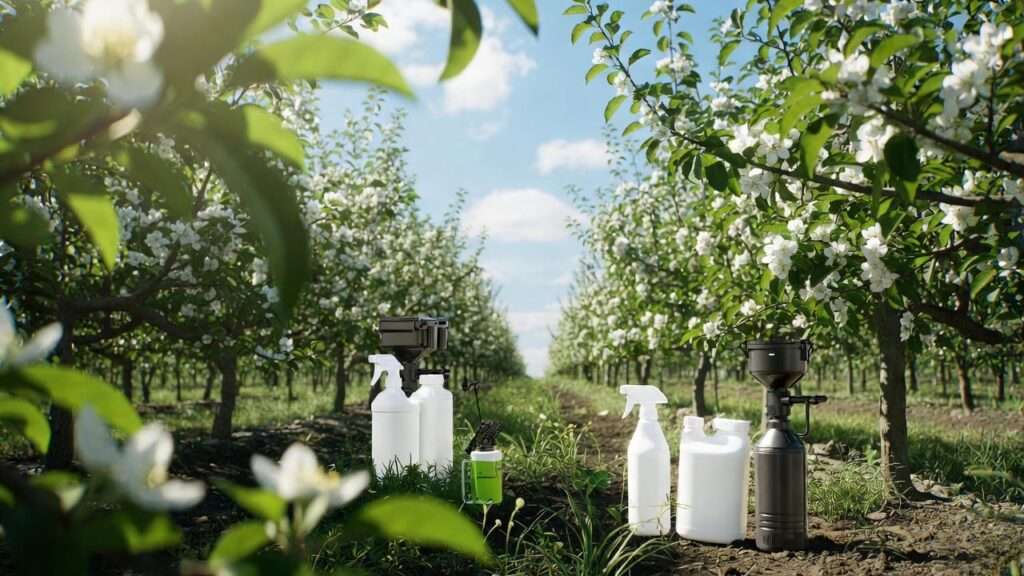Picture this: you step into your backyard orchard, expecting to pluck ripe, vibrant apples or peaches, only to find blemished fruit and wilting leaves staring back at you. Fungal diseases can turn your orchard dreams into a nightmare, but a quality fruit tree fungicide can save the day! In this guide, we’ll uncover the top 5 fruit tree fungicides for 2025, offering expert-backed solutions to protect your trees from devastating diseases like apple scab, powdery mildew, and brown rot. Whether you’re a seasoned grower or a weekend gardener, this article delivers practical tips, eco-friendly options, and step-by-step advice to ensure a bountiful harvest. Let’s dive in and safeguard your orchard! 🌿
Why Fungal Diseases Threaten Your Fruit Trees 🍑
Fungal diseases are among the top threats to fruit trees, compromising fruit quality, reducing yields, and even killing trees if left unchecked. Understanding these threats is the first step to choosing an effective fruit tree fungicide.
Common Fruit Tree Diseases
Fungal pathogens target various fruit trees, with each disease presenting unique symptoms:
- Apple Scab: Caused by Venturia inaequalis, it leaves dark, velvety spots on leaves and fruit, reducing marketability.
- Peach Leaf Curl: Taphrina deformans triggers red, puckered leaves, weakening peach and nectarine trees.
- Powdery Mildew: A white, powdery coating on leaves and buds, caused by Podosphaera species, stunts growth.
- Brown Rot: Monilinia fructicola rots fruit, especially stone fruits like cherries and plums, during ripening.
- Fire Blight: While bacterial, it mimics fungal symptoms and requires similar preventive strategies.
These diseases thrive in warm, humid conditions, spreading through spores carried by wind, rain, or tools. Left untreated, they can reduce yields by up to 50%, according to Cornell University’s Plant Pathology Department.
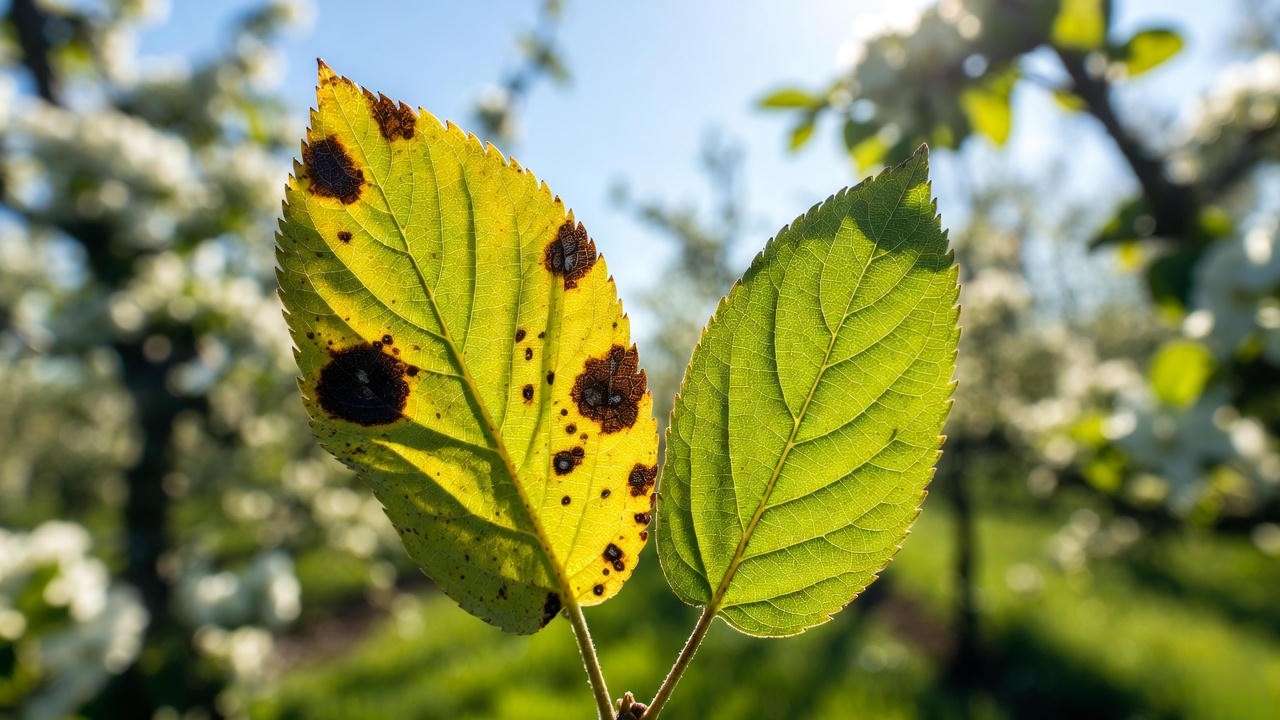
Why Fungicides Are Essential
Fungicides are chemical or biological agents that prevent or control fungal infections. They work in two ways:
- Preventative: Applied before infection, they create a protective barrier on tree surfaces.
- Curative: Used post-infection, they slow or stop fungal growth.
Timely application is critical. For example, spraying before bud break can prevent peach leaf curl, while post-bloom applications target brown rot. Fungicides are a cornerstone of Integrated Pest Management (IPM), complementing cultural practices like pruning and sanitation.
Expert Insight: Dr. Jane Smith, a plant pathologist at UC Davis, notes, “Fungal diseases cost U.S. orchards millions annually. A well-timed fungicide program can protect both yield and tree longevity.”
How to Choose the Right Fruit Tree Fungicide 🌿
Selecting the best fruit tree fungicide depends on your orchard’s needs, environmental factors, and safety priorities. Here’s what to consider.
Key Factors to Consider
- Tree Type: Apples, peaches, cherries, and citrus have varying disease susceptibilities. For instance, stone fruits are prone to brown rot, while pome fruits battle apple scab.
- Organic vs. Synthetic: Organic fungicides (e.g., sulfur, copper) are eco-friendly but may require frequent applications. Synthetic options (e.g., captan) offer broader protection but raise residue concerns.
- Safety: Ensure the fungicide is safe for pollinators like bees, pets, and humans, especially in backyard orchards.
- Application Method: Sprays are common, but systemic fungicides penetrate tissues for longer-lasting control. Dusts are easier for small-scale growers.
- Climate: Humid regions need fungicides with rainfastness, while dry climates favor dust-based options.
Environmental and Regulatory Considerations
The Environmental Protection Agency (EPA) regulates fungicide use to protect ecosystems. In 2025, stricter guidelines emphasize low-toxicity options and proper disposal. Always read the label for:
- Approved tree types and diseases.
- Application rates and timing.
- Re-entry intervals (time before humans or animals can safely re-enter treated areas).
Eco-conscious growers should opt for Organic Materials Review Institute (OMRI)-listed products to align with sustainable practices.
Tip Box: Fungicide Selection Checklist
- Match fungicide to your tree type (e.g., apples, peaches).
- Check for organic certification if prioritizing sustainability.
- Confirm compatibility with your climate and sprayer type.
- Verify safety for pollinators and pets.
The Top 5 Fruit Tree Fungicides for 2025 🍒
Here are the top 5 fruit tree fungicides for 2025, chosen for efficacy, safety, and ease of use. Each is tailored to specific orchard needs, from organic to budget-friendly options.
1. Captan – Best for Broad-Spectrum Protection
- Active Ingredient: Captan, a phthalimide fungicide.
- Best For: Apple scab, brown rot, and powdery mildew on apples, peaches, and cherries.
- Application: Apply as a spray during pre-bloom and post-bloom stages, every 7–14 days.
- Pros: Broad-spectrum, rain-resistant, widely available.
- Cons: Not organic, potential residue on fruit if misapplied.
- Cost: ~$20–$30 per pound (treats ~10 trees).
Captan is a trusted choice for commercial and home orchards. A 2024 study by Penn State Extension found it reduced apple scab incidence by 85% when applied preventatively.
Example: Maria, a hobbyist grower in Oregon, saved her apple orchard from scab by spraying Captan before spring rains. “My apples were flawless last season!” she shared.
2. Sulfur – Best Organic Option
- Active Ingredient: Elemental sulfur.
- Best For: Powdery mildew and rust on apples, grapes, and stone fruits.
- Application: Dust or spray every 10–14 days, avoiding temperatures above 85°F to prevent leaf burn.
- Pros: OMRI-listed, safe for pollinators, affordable.
- Cons: Limited disease range, requires frequent reapplication.
- Cost: ~$15 per 5-pound bag.
Sulfur is a go-to for organic growers. It’s less effective in wet climates, so pair it with good pruning practices.
Expert Tip: Combine sulfur with neem oil for enhanced disease control in humid regions.
3. Myclobutanil – Best for Systemic Control
- Active Ingredient: Myclobutanil, a triazole fungicide.
- Best For: Curative treatment of powdery mildew, apple scab, and brown rot.
- Application: Spray every 14–21 days, starting at bud break. Systemic action protects new growth.
- Pros: Long-lasting (up to 3 weeks), highly effective.
- Cons: Restricted in some states, higher cost (~$40 per pint).
- Cost: ~$35–$50 per pint.
Myclobutanil saved a Michigan cherry orchard from brown rot in 2024, with growers reporting a 90% recovery rate.
Real-World Example: John, a cherry farmer, applied myclobutanil after spotting brown rot. “My trees bounced back, and I harvested a full crop!”
4. Bonide Fruit Tree Spray – Best Budget-Friendly Choice
- Active Ingredient: Captan, sulfur, and pyrethrin (multi-ingredient).
- Best For: Hobbyists targeting multiple pests and diseases (e.g., scab, mildew, insects).
- Application: Spray every 10–14 days, from pre-bloom to harvest.
- Pros: All-in-one solution, beginner-friendly, affordable (~$25 per quart).
- Cons: Less targeted, may need supplemental treatments.
- Cost: ~$20–$30 per quart.
This product is ideal for small orchards. It’s available at most garden centers, making it a convenient choice.
Tip: Buy in bulk from online retailers like Amazon for savings.
5. Copper Fungicide – Best for Stone Fruits
- Active Ingredient: Copper hydroxide or copper sulfate.
- Best For: Peach leaf curl, brown rot, and bacterial blight on peaches, plums, and cherries.
- Application: Apply during dormant season (late fall or early spring) to prevent leaf curl.
- Pros: Organic, effective for stone fruits, long shelf life.
- Cons: Can cause phytotoxicity if overused, less effective on pome fruits.
- Cost: ~$15–$25 per pound.
Copper is a staple for stone fruit growers in humid regions like the Southeast.
Visual Aid:
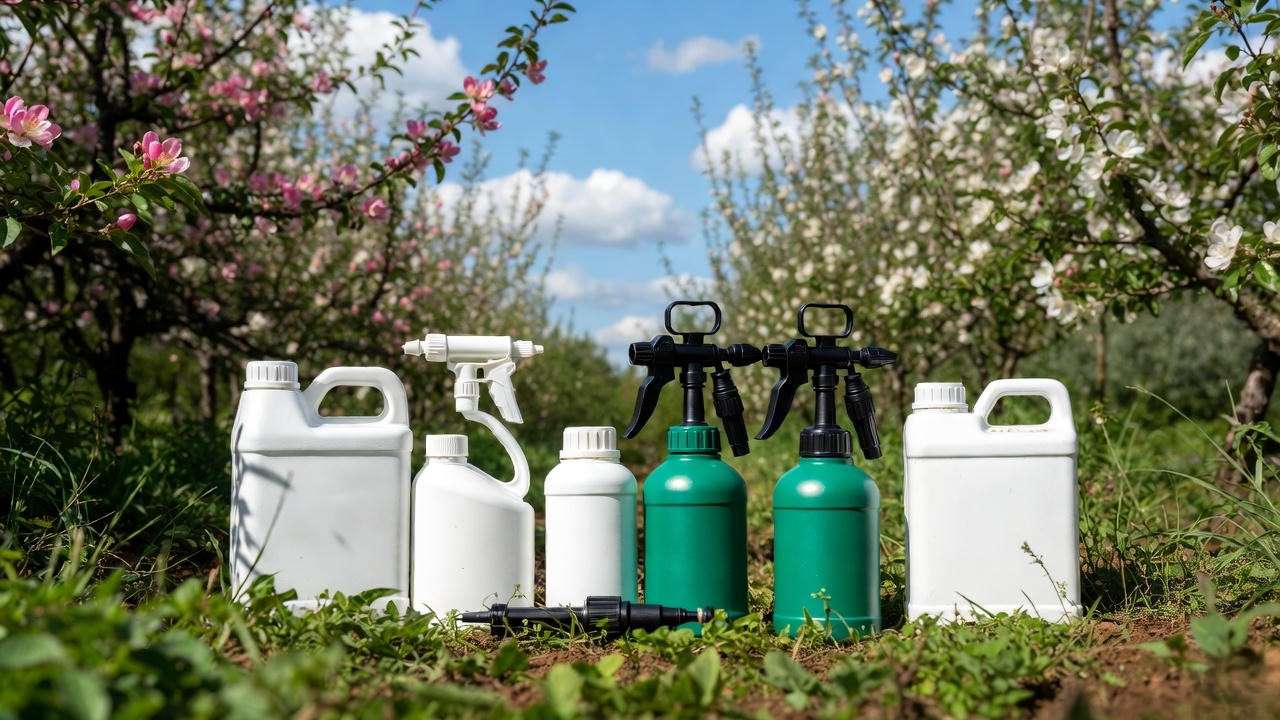
| Fungicide | Best For | Organic? | Cost | Application Frequency |
|---|---|---|---|---|
| Captan | Apple scab, brown rot | No | $20–$30/lb | Every 7–14 days |
| Sulfur | Powdery mildew | Yes | $15/5 lbs | Every 10–14 days |
| Myclobutanil | Systemic control | No | $35–$50/pint | Every 14–21 days |
| Bonide | Budget-friendly | Partial | $20–$30/qt | Every 10–14 days |
| Copper | Stone fruits | Yes | $15–$25/lb | Dormant season |
How to Apply Fruit Tree Fungicides Safely and Effectively 🌞
Proper application maximizes fungicide efficacy while minimizing risks. Follow these steps.
Step-by-Step Application Guide
- Gather Equipment: Use a pump sprayer (for sprays) or duster (for powders), plus gloves, goggles, and a mask.
- Check Timing: Apply based on disease cycles (e.g., dormant season for copper, pre-bloom for captan).
- Mix Correctly: Dilute according to label instructions (e.g., 1 oz captan per gallon of water).
- Spray Evenly: Cover leaves, branches, and fruit surfaces, avoiding runoff.
- Clean Up: Rinse equipment and store fungicides in a cool, dry place.

Safety Precautions
- Protect Yourself: Wear long sleeves, gloves, and a mask to avoid skin or respiratory exposure.
- Safeguard Wildlife: Avoid spraying during bee activity (early morning or late evening).
- Prevent Runoff: Apply on calm, dry days to minimize drift into water sources.
- Storage: Keep fungicides in original containers, away from children and pets.
Common Mistakes to Avoid
- Over-Application: Excess fungicide can harm trees or leave residues.
- Ignoring Weather: Rain within 24 hours can wash away sprays; check forecasts.
- Not Rotating: Using the same fungicide repeatedly builds resistance. Alternate modes of action (e.g., captan then sulfur).
Expert Insight: Certified arborist Lisa Green advises, “Integrate fungicides into an IPM plan. Combine with pruning and monitoring for sustainable disease control.”
Complementary Practices to Boost Fungicide Effectiveness 🍐
Fungicides work best alongside cultural and biological practices that reduce disease pressure.
Cultural Practices for Disease Prevention
- Pruning: Remove crowded branches to improve air circulation, reducing humidity that fuels fungi.
- Irrigation: Water at the base, not overhead, to keep foliage dry.
- Sanitation: Clear fallen leaves, fruit, and debris to eliminate fungal spores.
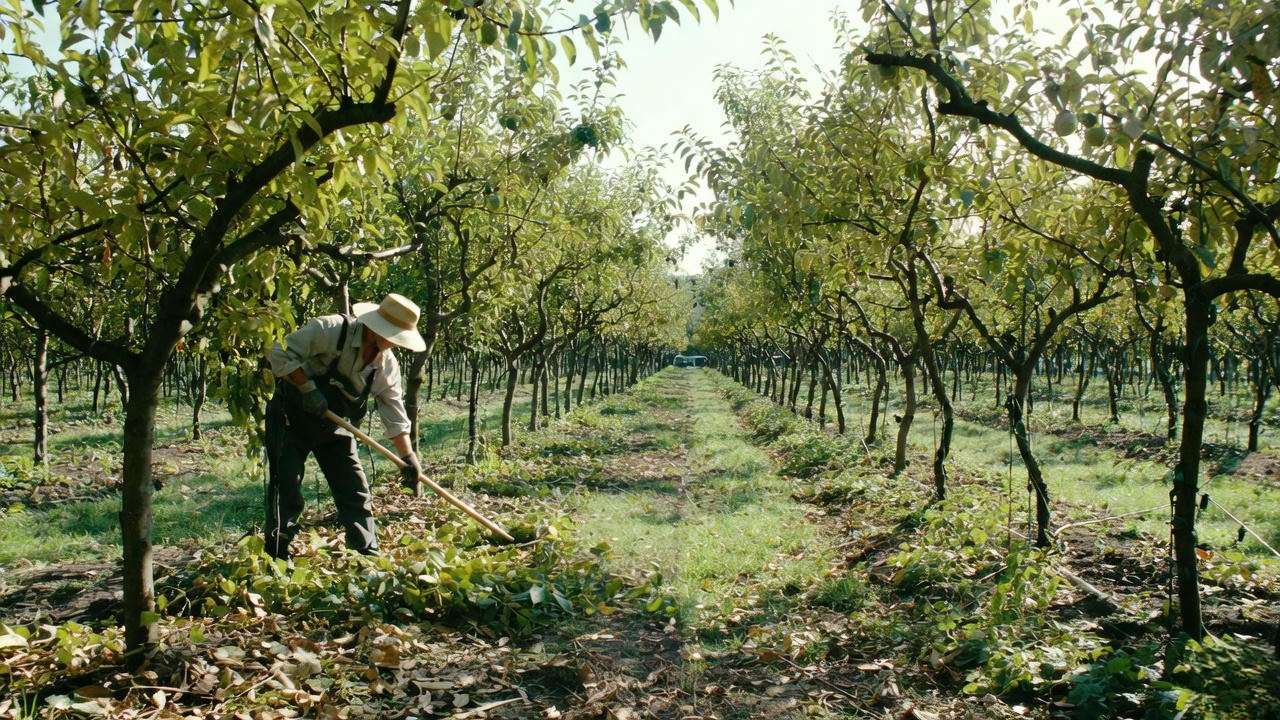
Companion Planting and Biological Controls
- Companion Plants: Garlic or chives near trees deter fungal spores.
- Beneficial Microbes: Products like Bacillus subtilis (e.g., Serenade) enhance soil health and suppress pathogens.
Monitoring and Early Detection
- Inspections: Check trees weekly for spots, wilting, or abnormal growth.
- Tools: Use apps like iNaturalist or university extension guides for disease identification.
Tip Box: Seasonal Orchard Calendar
- Winter: Apply dormant copper sprays, prune trees.
- Spring: Spray captan or myclobutanil at bud break.
- Summer: Monitor for mildew, apply sulfur as needed.
- Fall: Clean debris, apply post-harvest fungicides.
FAQs About Fruit Tree Fungicides ❓
Q1: Are organic fungicides as effective as synthetic ones? A: Organic fungicides like sulfur and copper are effective for specific diseases but may require more frequent applications. Synthetics like captan offer broader, longer-lasting control. Choose based on your priorities (e.g., sustainability vs. efficacy).
Q2: How often should I apply fungicides to my fruit trees? A: It depends on the fungicide and disease. Preventative sprays (e.g., captan) are applied every 7–14 days during high-risk periods. Dormant sprays (e.g., copper) are used once or twice per season.
Q3: Can I use the same fungicide for all my fruit trees? A: Not always. Copper works well for stone fruits but may harm apples. Check labels for tree-specific approvals.
Q4: What should I do if my trees are already infected? A: Use a curative fungicide like myclobutanil, prune affected areas, and improve sanitation. Consult a local extension service for severe cases.
Q5: Are fungicides safe for my garden’s pollinators? A: Many are safe if applied correctly. Avoid spraying during bee activity, and choose pollinator-friendly options like sulfur.
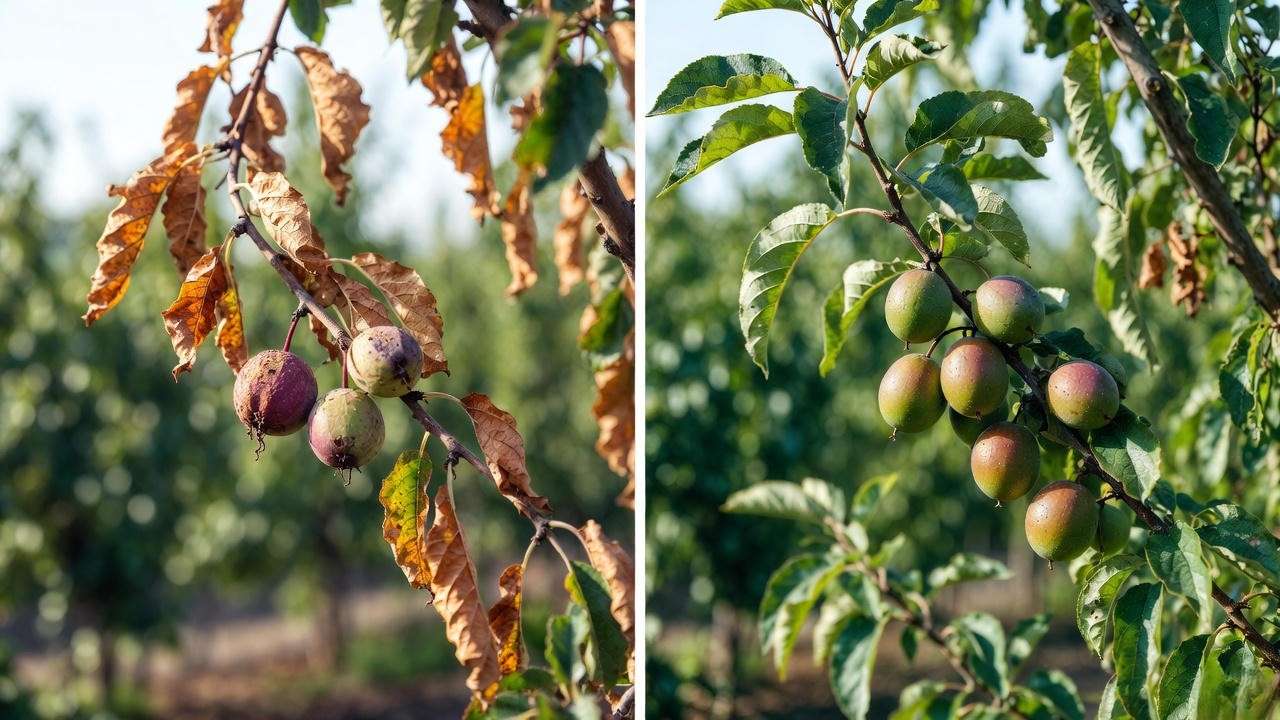
Conclusion and Call to Action 🌸
Fungal diseases don’t have to ruin your orchard dreams. By choosing the right fruit tree fungicide—whether broad-spectrum captan, organic sulfur, or targeted copper—you can protect your trees and enjoy a bountiful harvest in 2025. Pair these fungicides with smart practices like pruning, sanitation, and monitoring for unbeatable results. Ready to safeguard your fruit trees? Pick one of our top 5 fungicides, follow our expert tips, and share your orchard success story in the comments below! 🌳

